The iPhone 7 and iPhone 7 Plus Review: Iterating on a Flagship
by Joshua Ho & Brandon Chester on October 10, 2016 8:00 AM EST- Posted in
- Smartphones
- Apple
- Mobile
- iOS
- iOS 10
- iPhone 7
- iPhone 7 Plus
System Performance
Section by Brandon Chester
At the heart of a smartphone lies the SoC. While there's now an increasingly common belief that specifications don't matter, the truth of the matter is that almost all of the software features that users now take for granted in a smartphone have only been made possible by the continued improvements in hardware performance. Modern smartphones with high resolution displays and complex interfaces would not exist if the available CPU and GPU processing power hadn't advanced as much as it has. On top of that, performance is something of a gating factor for software development, as the innovation that happens in software has to happen within the boundaries of what can be done with the hardware. Specifications in a smartphone actually matter quite a lot, even if the user isn't actively aware of all the individual components that make up their smartphone's SoC.
With the iPhone 7 Apple doesn't have the benefit of a new major process node to help improve performance. Any improvements will be the result of architectural improvements, as well as improvements that have been made to TSMC's 16nm process since the release of the Apple A9, which was Apple's first FinFET SoC. It's important to note that one of the goals of A10 Fusion is improving dynamic range, so the focus isn't solely on improving performance. However, device performance seemingly must improve with each generation, and Apple is advertising a 40% improvement in CPU performance and a 50% improvement in GPU performance with A10 Fusion compared to A9.
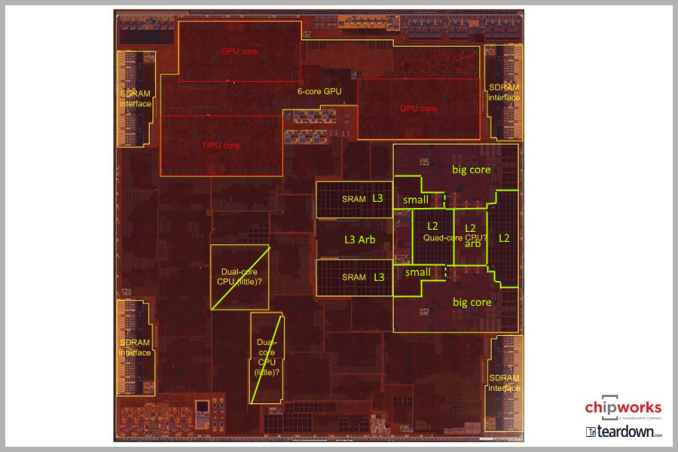
A10 Fusion's Floorplan (Special thanks to Chipworks)
While an in-depth look at A10 Fusion will have to wait until our seperate technology deep dive, we can still take a look at how performance has changed at a higher level. A10 Fusion's peak frequency is 2.3GHz, up from 1.8GHz on A9. This gives a theoretical improvement of 28% on its own, and the remainder will have to come from improvements to the architecture in Apple's (big) Hurricane cores. Based on our testing so far, Hurricane is not radically different from Twister (A9), but Apple has been making some optimizations. Meanwhile it should be noted that while A10 technically has four CPU cores – the two Hurricane cores and the two smaller cores – this is not a heterogeneous design, and only two cores are active at once. So for the purposes of high performance benchmarking, this means we're benchmarking the big cores nearly exclusively.
Anyhow, we've run our standard suite of benchmarks on the iPhone 7 and 7 Plus to see if A10 Fusion stands up Apple's performance claims.
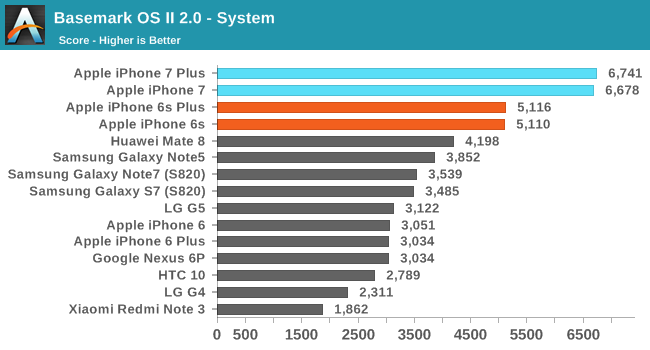
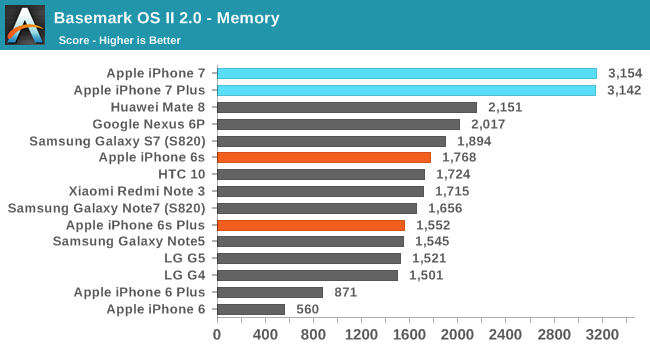
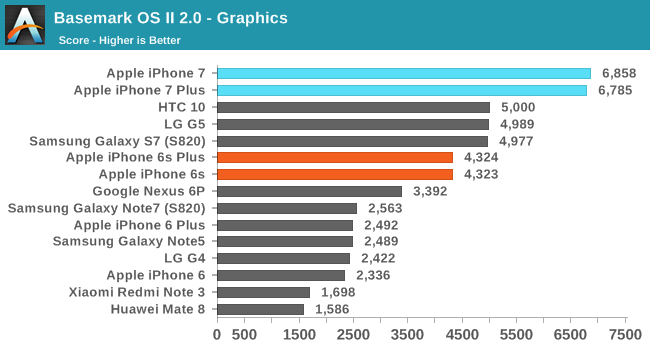
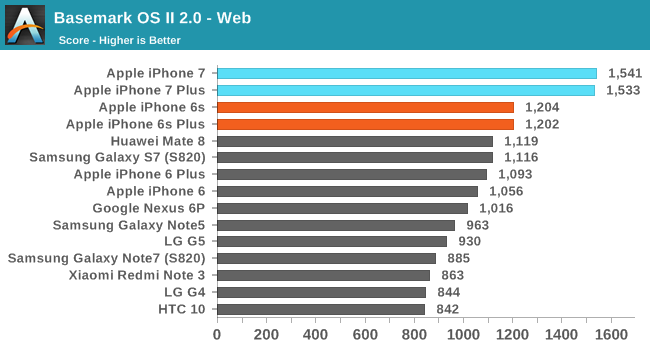

I've brought back BaseMark OS II for this review, although unfortunately the reason has less to do with wanting it back in the benchmark suite and more to do with there being very few cross-platform general system benchmarks nowadays. You can focus on the GPU, or the CPU, but the major system performance benchmark in mobile is PCMark and it remains exclusive to Android. BaseMark OS II is a pretty large optimization target now, and while it does test many aspects of the system it doesn't do so by directly simulating the tasks that a user would perform. Despite that, it helps in getting a holistic view of a device's performance by going beyond tests of a single component, so it's not without its uses.
The iPhone 6s and 6s Plus have remained the fastest overall devices in this test, so it's really just a matter of seeing how much Apple has improved. The latest generation of Android devices outpaced the GPU performance Apple's A9 SoC some time ago, so that's one area where Apple could stand to improve against the competition. As it turns out, they have. The iPhone 7 and 7 Plus show significant gains over their predecessors across the board. Performance in the system sub-test is up by 25-30%, and the graphics score is right in line with Apple's claimed 50% increase in performance. Web shows similar gains to system, which makes sense given that both are relatively CPU-bound.
The memory/storage test also shows a large improvement, which is interesting at first glance given that Apple didn't highlight any improvements in this area. However, this is just the result of the tested units being the 256GB model. On my retail iPhone 7 which is 128GB the memory score is essentially the same as the iPhone 6s which was also tested in a 128GB configuration. This comes down to the fact that these devices use a hybrid SLC/TLC storage solution, where the SLC storage can be used for writes and data can be moved later as needed. It's likely that on the 128GB iPhones the BaseMark OS II memory test is exceeding the size of the SLC cache, leading to lower scores based on the performance of the TLC NAND. On the 256GB iPhone the SLC cache is large enough to fit the entire data set used in the test, leading to a much higher score.
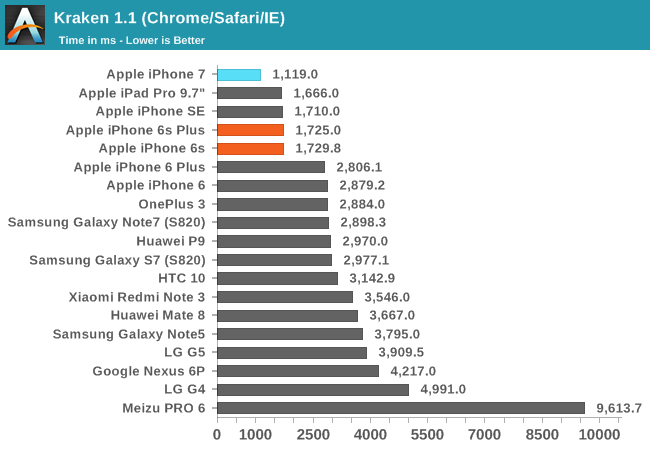
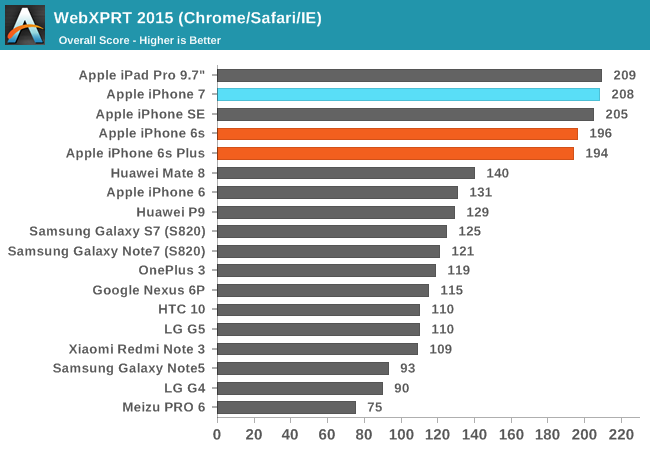
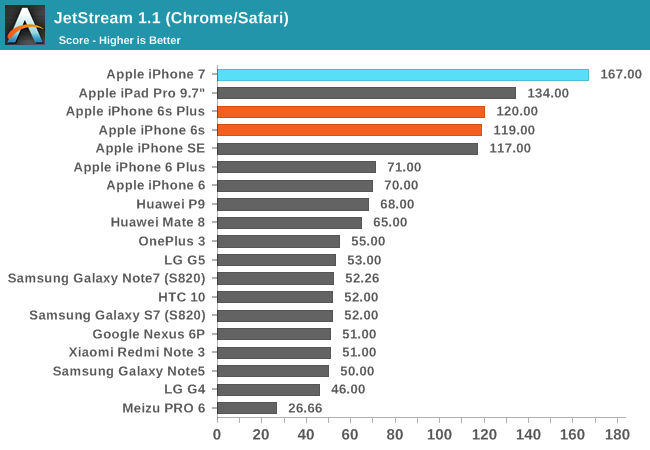
Web performance is an interesting case. While Apple's continued increases in single core CPU performance have benefited web performance with each generation, the truth is that improvements Mobile Safari's Nitro JavaScript engine have contributed a great deal as well. When looking at the charts you can see that there's a significant gap between the iPhone 7 and the next device, with the exception of WebXPRT where it's tied. What's more important than this gap is what the second device actually is. It's always another Apple device, and the same is true for the third device, and the fourth device, and so on. In Kraken and Jetstream the top seven devices on the chart are Apple's mobile devices, and the charts only have seven Apple devices in total. The Huawei Mate 8 is able to move ahead of the iPhone 6 in WebXPRT, but the gap between it and the iPhone 6s is still enormous. While Apple has continued to advance their web performance, it hasn't been with the immediate goal of beating the Android competition, as the best Android devices are still just trading blows with the iPhone 6.
WebXPRT is a small exception. As far as mobile benchmarks go, it's quite long and has short bursty workloads with pauses between each to simulate how a user would pause between different actions while using the browser. I suspect that in this case we're seeing the effects of A10 switching between its low power and high performance cores, causing parts of the test to be run on the little cores, which are not as performant. In fact, In the case of very quick actions that take only tenths or hundreths of a second to complete, it may not be possible to switch to the high performance cores before the operation has ended, causing the score to reflect the performance of the low power cores instead.
While it might seem reasonable to attribute the superior web performance of iOS devices to Apple's focus on improving single threaded CPU performance, the fact that Android devices with Cortex A72 CPUs are only matching Apple's A8 SoC shows that the gap is not only due to the CPU power available. Chrome's generally poor performance on Android is a significant limiting factor, and you can see in the chart how the improvement in Android device CPU performance over time has not translated into anything close to the sorts of gains that Apple has seen in the same period. While there are customized versions of Chromium like Snapdragon Browser that provide optimizations for a class of SoCs, it doesn't look like the gap between Android devices running Chrome and iOS devices running Mobile Safari is going to close any time soon, and if anything, it's only widening with each year.


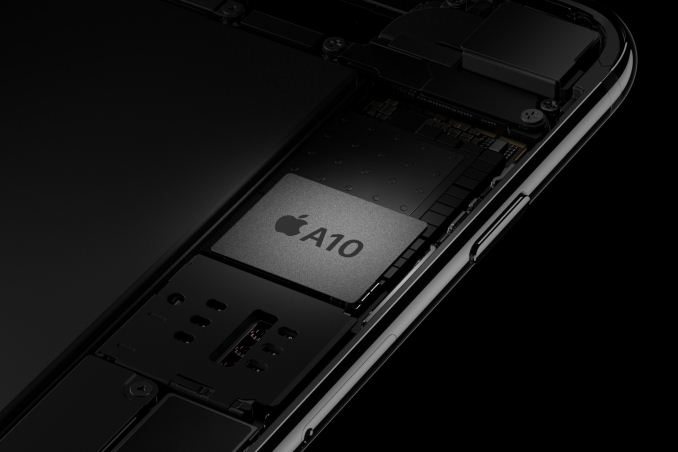








377 Comments
View All Comments
Daniel Egger - Sunday, October 16, 2016 - link
Amen to that.techconc - Monday, October 10, 2016 - link
Blind tests are interesting, but not necessarily accurate. For example, if you take 13,000 random people off of the internet and show them pictures, it shouldn't be very surprising that the majority of them will prefer over saturated and inaccurate images. For the untrained eye, these are often more aesthetically pleasing. However, for real photographers that actually care about things like color accuracy, they are a joke. It also shouldn't be surprising that a much smaller percentage of the random population is able to accurately assess a photo. That's not to suggest that I think the iPhone wins in every photo. Rather, I don't take these random polls very seriously and treat them for what they are.cknobman - Monday, October 10, 2016 - link
techconc and grayson you are both correct and if you read the article it does mention the exact points you bring up. People tend to prefer over saturation and colors that pop.Its a very similar reason why TV manufacturers set the default settings so high and why people are drawn to TV's on the showroom floor.
All the same, most people are not professionals, and most professionals do not use a smartphone as their main camera.
techconc - Monday, October 10, 2016 - link
Fair enough... I'm just trying to understand the point you were trying to make with the blind photo test. If it's to point out that most people viewing such surveys don't know what they're looking at, then I agree with you. However, from the tone of your post, you seemed to be using this as the basis for claiming how much better the S7 was.On a side note, you mention the headphone jack. I think we can all agree this is a minor inconvenience for some in the short term, but I wouldn't agree with your characterization overall. For starters, it comes with lightning earbuds right out of the box. Most people are now using bluetooth wireless headsets anyway. For that matter, I really like what Apple has done with their W1 chip. It really fixes problems with existing bluetooth synchronization. The ability to use the same headphones with all of my devices seamlessly without having to worry about individual pairing is very appealing. Finally, as a fallback, there is always the adapter for legacy equipment. That's not a great solution but it's not the end of the world either. The fact that Apple is only charging $9 for these adapters pretty much makes it a non-issue. Just keep a couple lying around or connected to your headphones, etc.
steven75 - Wednesday, October 12, 2016 - link
In other news, TVs in super oversaturated "demo" mode rated "best display" aware by Joe Sixpack. News at 11!ex2bot - Wednesday, October 12, 2016 - link
I can't see the pixels on my 6 Plus's "tiny" display. At all. Now you *will* miss the display *quality* going between the best AMOLED screens and LCDs. The 7 and 7 Plus have excellent LCD displays with better color space than the 6s, but they're not AMOLED.milli - Monday, October 10, 2016 - link
Anand's Apple reviews have been extremely pro-Apple for as long as I remember. Even in the old days when their laptops were having obviously negatives, it was not spoken about.Any iPhone review on this website is generally very positive. They usually accomplish this by not talking about the negatives.
Anand's iPhone reviews are interesting for one thing only and that's the detailed info of the SOC.
mjh483 - Monday, October 10, 2016 - link
It's giving credit where it's due.jospoortvliet - Tuesday, October 11, 2016 - link
Amen, I found this a decent ando balanced article!akdj - Friday, October 14, 2016 - link
Make that three of us ...excellent, well studied review. Many thanks for your work and realize that most of us sincerely DO appreciate your efforts! It's actually become humerus that the same three or four doorknobs continue to frequent, completely manage to miscomprehend and actually take the time and expend the effort to post the same drivel they posted ...last year. Same time. Same place. Year in. Year out. Just have to zoom by the first 80-100 whining posts from said three or four 'knobs and enjoy the remainderThey inevitably tire out or their mother's confiscated their phones and computers.
Looking forward to seeing the 'deep dive' and, my bad for forgetting the author who's daily driver is Android gear ...but one question for him.
Is the iPhone 7/7+ enough _____ to consider jumping ship? :-)
Thanks again, keep up the great work and know a small percentage of your readership will ever even 'venture' into the comments and even fewer will take the time to register and post. There's a huge population that laughs at DBag comments ...even definitions modified to refer to them and their DBagEry. Both as a noun and a verb. "Troll".
J